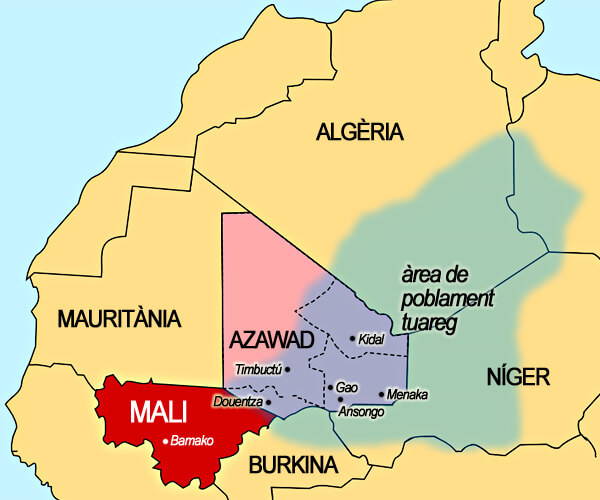
Coordination of Movements of Azawad gets more regional decentralization from Bamako, more investments for Mali’s northern regions · Malian government welcomes agreement as it does not force it to concede federalism, autonomy · Deal sparks partial discontent within CMA, Kidal’s Tuaregs.
Azawad’s fourth large rebellion in the last half century officially came to an end Sunday as the government of Mali and the Cordination of Movements of Azawad (CMA) signed an Algerian-brokered peace deal. The agreement, which had been insistently demanded by major Western powers, finalizes multilateral negotiations started in 2013.
Under the agreement, the CMA accepts the “unity and territorial integrity of Mali,” a key point that was a red line for Bamako. In return, Mali agrees to implement a more decentralized system of government, with regional assemblies enjoying enlarged powers and elected under universal suffrage. Furthermore, Mali recognizes Azawad to be a “human, sociocultural, symbolic reality shared by different populations of the north.”
Azawad is not set to have one single elected assembly but five, one for each of the area’s regions, which are Timbuktu, Gao, Kidal, Taoudeni and Menaka -the last two to be newly-created, as the Malian government had already decided in 2011. Still, the peace deal says that an Advisory Council of the Northern Regions will be established in order to coordinate some of their policies; some Malian nationalist sectors perceive that to be the germ of an Azawadi government.
The deal also provides for increased representation of the regions of Azawad in Malian institutions, and greater economic investment by the Malian state in the area.
A large, diverse territory
Azawad covers some 850,000 square kilometers, stretching from the Sahara to the Niger river through the Sahelian strip. Most Azawadis are either Tuareg, Arab, Fulani or Songhai. Each one of those peoples is divided into multiple sub-groups and clans, and not all of them hold the same political interests or identities.
The territorial concept of Azawad is mostly claimed by the CMA, which brings together several political and military groups who mostly draw their membership from certain Tuareg and Arab groups. The most important among the CMA groups are the National Movement for the Liberation of Azawad (MNLA, mainly Tuareg and secular), the High Council for the Unity of Azawad (HCUA, mainly Tuareg and Islamist), and the Arab Movement of Azawad (MAA).
The MNLA launched a rebellion in January 2012 that managed to expel the Malian army from northern Mali. A declaration on Azawadi secession followed suit. But independence was short-lived: in June 2012 several jihadist groups drove the MNLA out of the main cities of Azawad (Gao and Timbuktu) and captured most of its territory. In January 2013 the situation again changed dramatically, as a French-led military operation expelled the jihadists out of most of Azawad.
From then onwards, the MNLA and other CMA groups started peace talks with the Malian government and recaptured part of the territory previously lost to the jihadists. The MNLA abandoned its pro-independence claims and demanded the conversion of Mali into a federal country instead. Bamako did not accept it. The HCUA proposed a statute of autonomy for Azawad, but that idea was not included in the final agreement either.
A CMA majority in the Malian army in Azawad
After Algeria and Mali announced a peace deal proposal in February 2015, the CMA asked for “improvements” in the text for Azawadi groups to be able to sign it.
In last minute negotiations between the CMA and the Algerian mediation, the Azawadi groups obtained some further concessions. According to the CMA leaders, they were enough to sign the deal. A very important one among them was the compromise that Malian army units to be deployed across Azawad will be mostly made up by members of the Azawadi politico-military groups.
But the signing of the agreement has raised protests and opposition both among some sectors of the CMA rank and file and from some Tuareg groups in the Kidal region, where the MNLA and HCUA enjoy greater support. Those opposed to the deal believe the CMA negotiators have obtained very little, especially given the fact that the recognition of Azawad as a political and legal entity has not been achieved.
Over the last few weeks, the CMA leaders have found themselves under intense pressure to sign the deal. On the one hand, because of the pressure exerted from France and other Western countries, who do not want to see Azawad as a lawless region where jihadists can operate with impunity. On the other, because of the CMA’s recent military weakness, including the loss of some towns to a Bamako-allied coalition of Tuareg, Arab, Fulani and Peul militias.

Indigenous Peoples are putting their bodies on the line and it's our responsibility to make sure you know why. That takes time, expertise and resources - and we're up against a constant tide of misinformation and distorted coverage. By supporting IC you're empowering the kind of journalism we need, at the moment we need it most.